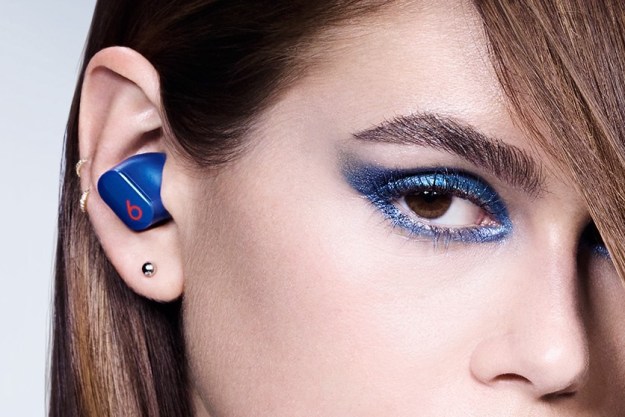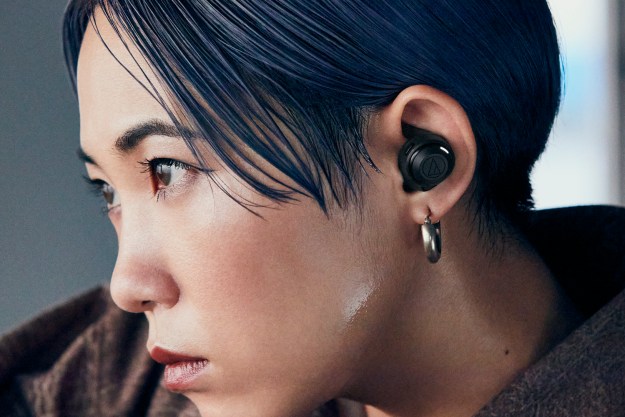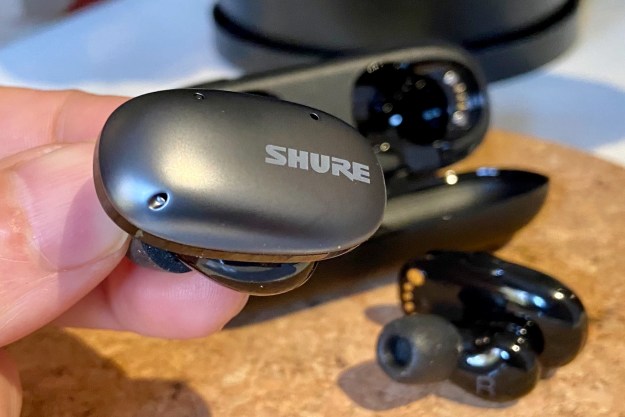
“Big on size, comfort, and precision, these are buds for critical listening.”
- Clear, precise, and detailed sound
- Very comfortable
- Very good transparency mode
- Easy to use customizable controls
- Awesome EQ settings
- Good call quality
- Big buds, big charging case
- No ANC or autopause
- No wireless charging
- No water resistance
Shure is no stranger to high-performance audio. The company’s in-ear monitors (IEMs) and microphones have been go-to equipment for musicians and audio professionals for decades. But when it comes to the true wireless earbuds market, Shure has only just stepped into the ring with its $199 Shure Aonic Free. Was it worth the wait? And how do these new buds compare to products from more established brands like Sony, Jabra, and Apple? Let’s check ’em out.
A bigger set of buds

Let’s address the elephant in the room: The Shure Aonic Free are big. They use a very similar design to Sony’s previous flagship model, the WF-1000XM3, that places the electronics, battery, and other goodies in a lozenge-shaped nacelle that sits quite prominently outside your ear.
Shure’s design is even bigger than Sony’s, making the Aonic Free some of the biggest buds we’ve ever tested. Thankfully, those nacelles look pretty sleek, with a relatively thin profile and a gunmetal satin finish that gives the plastic a high-end, sophisticated look. If you really want to draw attention to yourself, they’re also available in red. But despite their size, they’re also remarkably light, actually weighing less than the Sony XM3 by one gram.
There’s a ton of precision and detail, especially in the midranges and higher frequencies.
And while there’s no denying that these buds are really big, the design has two distinct advantages. First, with all of the guts of the buds outside your ear, the part that actually fits inside your ear is tiny, and extremely comfortable. Shure uses memory foam eartips instead of silicone, something that adds to the comfort level by reducing pressure points.
Not everyone loves the sometimes squishy feeling of memory foam, but I’m a big fan. Once inserted, the fit is very secure, but it won’t survive heavy activity as well as buds designed for that purpose. If you run, you should expect to have to readjust them regularly. In fact, you may want to avoid using the Aonic Free for workouts: They’re some of the only earbuds on the market that offer zero official protection from water in terms of an IPX rating.
Second, the big external nacelles make it really easy to press the multifunction button that sits on the top edge. Accidental presses are almost entirely eliminated, and you likely won’t accidentally dislodge an earbud while using those buttons.
To go along with the big buds, the Aonic Free comes with an equally large charging case. It absolutely dwarfs the tiny package that is the AirPods Pro case, and I doubt many people will find it pocketable. It also lacks wireless charging, which is an unfortunate miss at this price. Still, it’s robustly built, the lid flips open and closed easily via a big and study hinge, and getting the Aonic Free in and out of their charging sockets is really easy.
I Shure like the sound
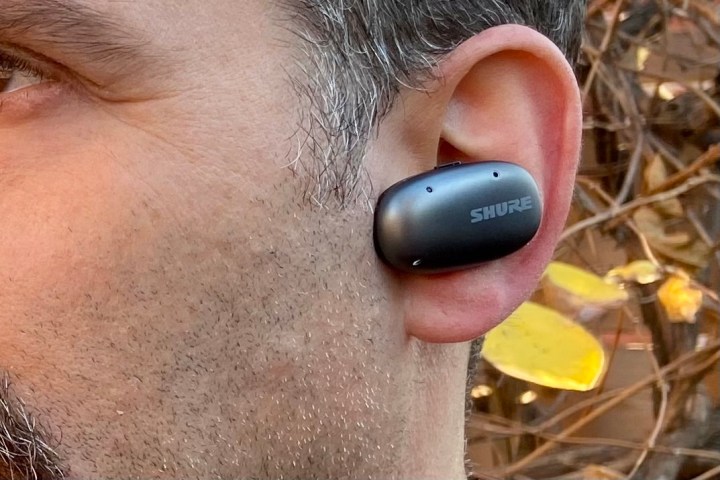
In keeping with Shure’s reputation for stage- and studio-quality gear, the Aonic Free possess a neutral and very clear sound signature. Thereis a ton of precision and detail, especially in the midranges and higher frequencies. Throw on a track like Dire Straits’ Six Blade Knife and Mark Knopfler’s unmistakable Stratocaster work becomes a tactile experience — you can almost feel the strings under his expert hand.
Bass response is tightly controlled, showing up only when needed, and never overwhelming the other frequencies. Such a conservative approach to bass can give the Aonic Free a cold sound if you’re used to headphones or earbuds like Sony’s WF-1000XM3 or XM4.

If this is all Greek to you, suffice to say that it’s an unheard of degree of EQ control for a set of true wireless earbuds and those who like to get into the sonic weeds will love it.
It’s worth mentioning that the Aonic Free don’t produce as much volume as some other well-respected earbuds on a percentage basis. In other words, at 50% volume on my iPhone, the Aonic Free were considerably quieter than the Jabra Elite 7 Pro or the Technics EAH-AZ60. I don’t consider this a problem — they can still get plenty loud — but you may find you need to run these earbuds at a higher setting than you’re used to.
It’s also worth noting for Android users that the Aonic Free support the aptX codec, which could be helpful in situations where audio lag (latency) is an issue.
Total control

The Aonic Free don’t have active noise cancellation (ANC), but thanks to those foam eartips, they do an excellent job of passively blocking outside sounds. There were a few occasions where I felt ANC might have blocked a bit more, but not many. What they do have is a very good transparency mode, which you can adjust in the Shure Play app to let in a little or a lot of the sound around you. At its maximum setting, it actually amplifies some of these sounds, so some judicious tweaking will be needed.
I love that Shure has included a feature it calls PausePlus, which lets you automatically activate transparency mode when you pause your music. Too many earbuds require you to first pause, then switch to transparency, which can be annoying when someone wants to talk to you.
The Shure Play app also gives you total control over the multifunction buttons. You can assign up to three different commands per earbud, including play/pause, track skip forward/back, transparency on/off, and voice assistant access. On top of that, you can choose if you want to control the volume using a fourth gesture. It’s admittedly a bit cumbersome — you need to do a press and then a long press — but it’s a handy option nonetheless. The one thing that Shure has omitted are wear sensors that can trigger an automatic pause when you remove one or both earbuds — another surprise given how many other earbuds at this price have it as a standard feature.
Your options for phone calls include muting the mic and switching between two calls, both of which are rare features. You can also use each earbud independently for both music and calls.
Avoid the wind
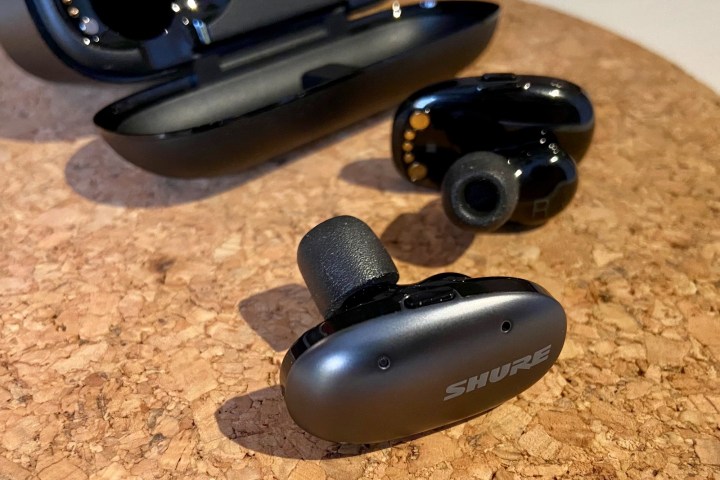
Call quality on the Aonic Free can be excellent, but you’ll need to avoid windy or very loud situations. The microphone does a great job of capturing the full tone and resonance of your voice, with little to no distortion, but it struggles to maintain that quality under adverse conditions. They’re definitely not the earbuds you want for making calls while navigating dense traffic on a bike, but they’ll perform admirably for Zoom calls or anywhere you can find relatively quiet conditions.
Speaking of Zoom calls, the Aonic Free are the first set of buds I’ve encountered that can automatically turn on a red LED light when you’re on a call to let others know that just because you’re not speaking, you’re still not to be interrupted. It’s a throwback to the earliest days of Bluetooth, but I think it’s brilliant — all
More power, please

Shure claims that the Aonic Free can get about seven hours on a single charge, and from what I can tell, that’s accurate if you listen at 50% volume. But as I mentioned above, because these buds run quieter than other models, you’ll probably end up listening at 60% or higher and this will reduce battery life a bit.
I’m OK with that — six to seven hours is still plenty for most folks. But what I can’t understand, given their huge charging case, is why you can only recharge the earbuds twice, for a total of 21 hours of playtime? If the Aonic Free were really small — say, AirPods Pro small — I would be inclined to accept this (though even the AirPods Pro have a longer total time of up to 24 hours), but the Aonic Free have no such excuse.
Our take
Though bigger than most
Are there better alternatives?
In terms of pure clarity, detail, and EQ control — that so-called studio-quality sound — you’ll be hard-pressed to find a better set of
$200 Jabra Elite 7 Pro: For the same price as the Aonic Free, the Elite 7 Pro have it all: Great sound, great ANC, great transparency, tons of customization, long battery life, wireless charging, and an IP57 rating that makes them effectively waterproof. Oh, and they’re way smaller, too. Audio purists will still prefer the Aonic Free’s incredibly accurate sound, but I think the Elite 7 Pro sound pretty great, too.
$230 Technics EAH-AZ60: For a slightly bigger investment, the AZ60 offer fabulous ANC and sound quality that rivals the Aonic Free, but with a slightly warmer default signature, which will appeal to folks who don’t love the sometimes overly precise Shure sound. The Technics also have Sony’s LDAC codec for wireless hi-res audio and Bluetooth multipoint for connecting two devices to your earbuds simultaneously.
How long will they last?
Given their total lack of water protection, this will very much depend on how careful you are with the Aonic Free. Their build quality appears to be excellent, however, and Shure backs them with a two-year warranty, which is unusual in this product category. That could be a good sign that they’ll fare better over the long term, but as with all
Should you buy them?
Yes, but only if you seek what the Aonic Free offer — a highly detailed, precise, and customizable sound, with very few other bells and whistles. For everyone else, you’ll find better options at the same price or less.
Editors' Recommendations
- Best wireless earbuds for 2024: Sony, Bose, Soundcore, and more
- Huawei joins the open-ear trend with its FreeClip wireless earbuds
- Sennheiser Momentum True Wireless 3 get Bluetooth multipoint and hi-res audio
- The new JBL Live Pro 2 and JBL Live Free 2 are now available
- Bang & Olufsen debuts waterproof Beoplay EX wireless earbuds




